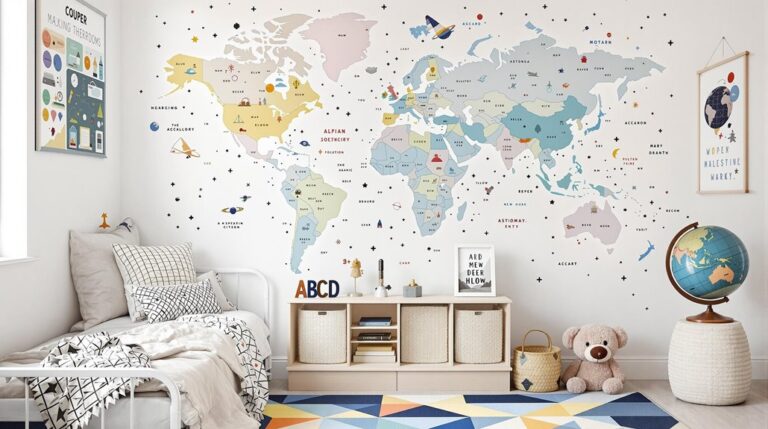To create a playful children's room, start by choosing a theme that matches your little one's interests—think dinosaurs, fairy tales, or even outer space! Personalize with custom decor, displaying their artwork for that warm sense of ownership. Bright colors and whimsical patterns on ceilings can invigorate, making the space feel alive. Don't underestimate multi-functional furniture—bunk beds that double as play zones are your best friends! Finally, make tidying up an adventure with themed storage solutions. Picture a room that's not just a space but a canvas for dreams—curious to know more about crafting this magical haven?
Briefly keys
- Choose a timeless theme aligned with the child's interests, using personalized decor to reflect their personality and create a sense of ownership.
- Establish interactive zones for play and learning, incorporating art supplies, STEM toys, and role-playing props to encourage creativity.
- Use bright colors and cohesive palettes to create an engaging atmosphere, balancing bold hues with neutral accessories for a harmonious look.
- Select multi-functional furniture, such as loft beds and collapsible chairs, to maximize space and adapt to the child's evolving needs.
- Incorporate themed storage solutions and cozy seating to enhance comfort, making organization fun while creating distinct activity zones within the room.
Selecting the Perfect Theme
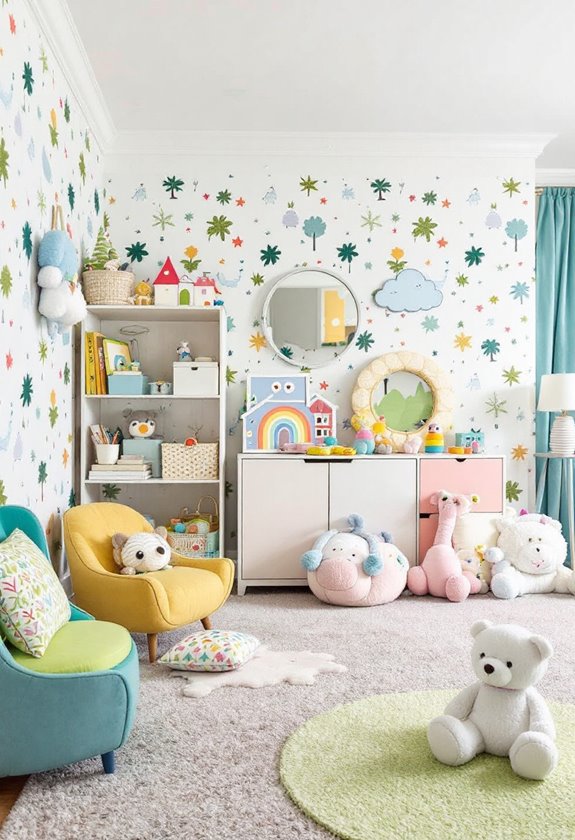
Choosing the ideal theme for a child's room is fundamental in crafting a space that mirrors their personality and passions. When it comes to theme selection, aligning with your child's current interests is vital. Whether they're fascinated by dinosaurs or dream of fairy tales, incorporating these elements can transform a simple room into an imaginative sanctuary.
Opt for timeless motifs, steering clear of trendy characters that may quickly fade like last year's fashion. To create an immersive environment, consider using bold wallpapers and 3D objects that leap out at you—think bugs and plush toys that practically beg for a hug. Subtle accents, like animal-themed clocks, can maintain a playful atmosphere without overwhelming the senses. Incorporating animal-themed decor can inspire curiosity and learning, encouraging exploration of scientific themes.
Balancing lively themes with classic touches guarantees the room evolves as your child does, keeping it relevant through the years. Picture a sophisticated yet whimsical space—perfect for both a curious toddler and a budding pre-teen.
And remember, easy updates are key; peel-and-stick decals are your best friends for a quick refresh. In the end, the goal is to curate a room that feels like a cozy retreat, encouraging creativity and comfort.
Designing Interactive Play Zones
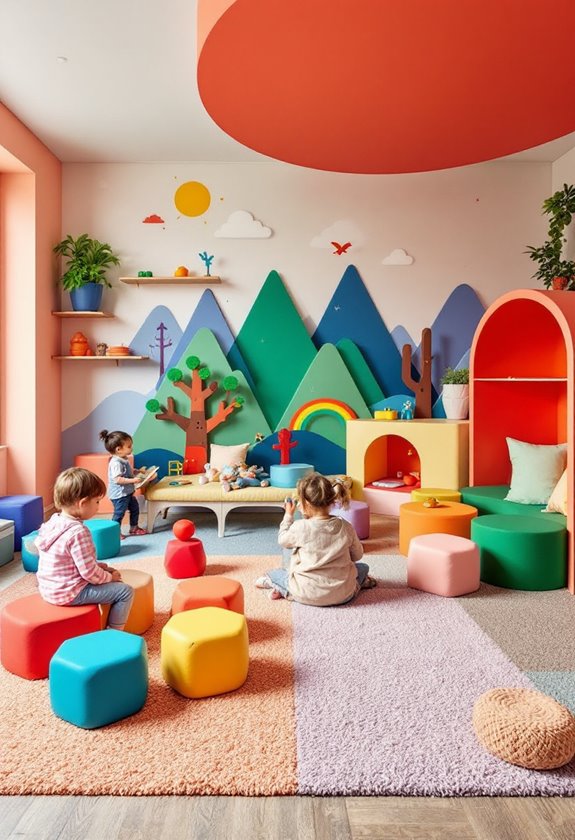
Creating interactive play zones within a child's room is essential for fostering imagination and creativity. Envision this: a lively space where little hands can plunge into creative play without the fear of making a mess.
Establish dedicated areas, like an art corner stocked with accessible supplies—think colorful pens, endless rolls of paper, and a chalkboard door begging for doodles. Accessible storage for art supplies increases usage and creativity, allowing children to freely express themselves.
Incorporate tools that spark joy and exploration. Wall-mounted coloring rolls and art caddies can instantly transform a mundane corner into an artist's paradise. Organize supplies in trendy storage units like IKEA TROFAST, making everything easy to find, because who has time for treasure hunts at playtime?
Don't forget the magic of role-playing! Provide props like dress-up costumes and themed play areas that invite children to enter their wildest fantasies. Visualize your child hosting a tea party with stuffed animals or starting on a daring pirate adventure.
Lastly, welcome nature and sensory exploration by adding elements like plants or a sensory panel. These interactive zones not only offer fun but also nurture responsibility and curiosity—an absolute win for every parent.
Creating Colorful Walls and Ceilings

Interactive play zones set the stage for a child's creativity to flourish, but the ambiance of the room plays an equally significant role in enhancing that experience. One of the most impactful ways to set this stage is through colorful walls and ceilings. Bright colors like red, blue, and yellow can create a lively atmosphere, while soft pastels invite a sense of calm—perfect for those cozy reading corners.
It's fascinating how color psychology works: bold hues stimulate a child's senses, igniting their creativity like a spark. The right colors can even enhance cognitive development, making learning more enjoyable and effective.
Now, let's talk about ceiling patterns. Striped ceilings can add a delightful illusion of height, making the room feel expansive, while whimsical prints like stars or animals create a magical environment.
Picture your little one lying on their bed, gazing up at painted circus animals or twinkling stars—pure enchantment!
Of course, neutral accessories can balance out those bold ceiling colors, ensuring the room feels cohesive and thoughtfully designed.
Personalizing the Space
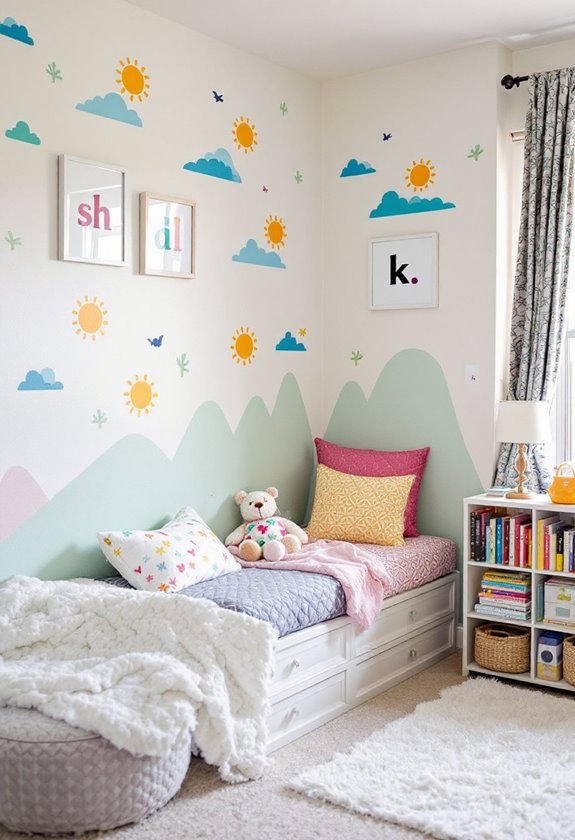
Personalizing a child's room can elevate the space from merely functional to genuinely special, reflecting their unique personality and interests. Start by choosing a theme that resonates with your little one—be it fairy tales, space adventures, or enchanted forests.
Once the theme is set, immerse yourself in the delightful world of custom decor. Envision plush pillows emblazoned with their name or whimsical wall art that showcases their favorite characters. Personalized artwork, like framed illustrations of their own drawings, adds an emotional touch that transforms bare walls into a canvas of memories. Incorporating a range of designs and colors for custom decor can enhance the overall aesthetic and appeal of the room.
Don't stop at wall art; consider incorporating fun items like custom step stools or bath towels featuring their name. These seemingly small details can make a big impact, creating a sense of ownership and belonging.
And let's not forget the charm of displaying their art—nothing says "this is my sanctuary" quite like their masterpieces adorning the walls.
As you navigate this creative process, remember that the goal is to create a space that evolves with your child. Keep it playful, lively, and above all, uniquely theirs, ensuring their room remains a magical retreat for years to come.
Enhancing Lighting and Comfort
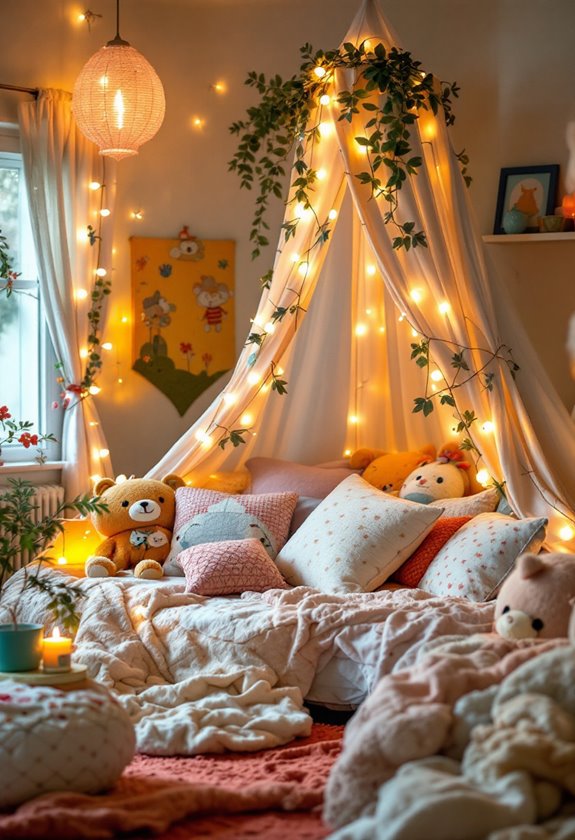
Lighting and comfort are crucial components in designing a children's room that fosters both play and relaxation. Think of lighting techniques as the stage hands of a delightful performance—setting the mood just right.
Ceiling lights provide a steady glow, while playful table lamps shaped like animals or cars add whimsy to study or play areas. And let's not forget LED lights with their RGB functions; they can transform a room into a cosmic adventure or a cozy retreat with just a flick of a switch. Proper lighting is essential for various daily activities and tasks, ensuring that children can engage in their favorite hobbies with ease.
Comfort essentials are equally important. A sturdy bed frame guarantees your little one's dreams are sweet and uninterrupted. Add in a charming headboard, and suddenly, bedtime feels like a grand event.
Swivel gliders offer a gentle motion, perfect for those post-playtime cuddle sessions. Consider durable step stools that let kids reach new heights—literally and figuratively—instilling a sense of independence.
Finally, smart storage solutions keep the chaos of toys at bay, fostering a sense of order amid the delightful chaos of childhood.
With the right lighting and comfort choices, a child's room can become a cherished haven of joy and imagination.
Incorporating Educational Decor
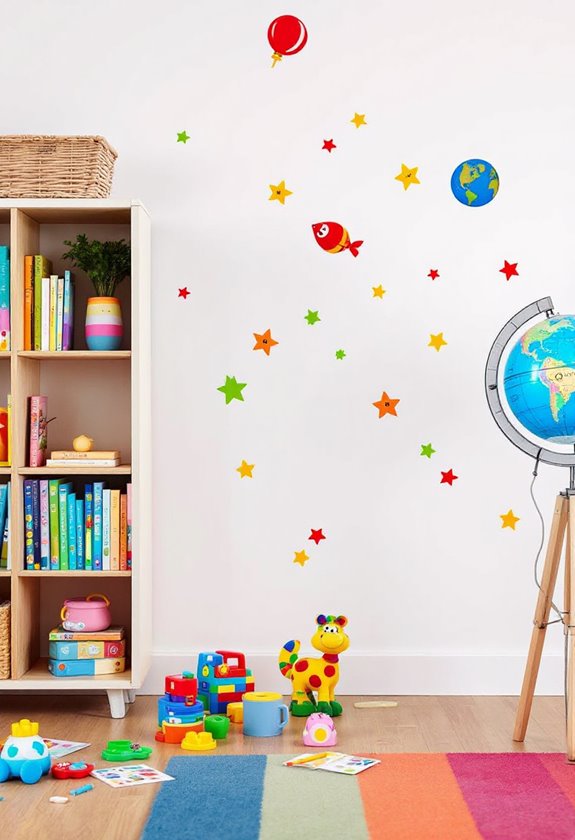
A thoughtfully designed children's room goes beyond mere aesthetics; it serves as a dynamic environment that promotes learning and creativity. Incorporating educational decor transforms the space into a sanctuary of artistic inspiration, where children can explore their imaginations while absorbing knowledge.
Begin by creating a gallery wall to showcase your child's masterpieces. Framing their artwork isn't just decor; it's a celebration of their creativity, a reminder that their imagination knows no bounds.
Add thematic elements like botanical prints or bird-themed wallpaper, which can spark curiosity about nature and the world around them. Additionally, consider incorporating natural materials to create a calming atmosphere that fosters a deeper connection to the environment.
Interactive surfaces, such as a chalkboard wall, invite spontaneous doodling and writing practice, while sensory tables filled with sand and water offer hands-on learning experiences that are as messy as they are fun.
Don't forget about storage! Brightly colored lockers or cubbies encourage kids to tidy up after their creative escapades, an essential life skill disguised as play.
Choosing Multi-Functional Furniture
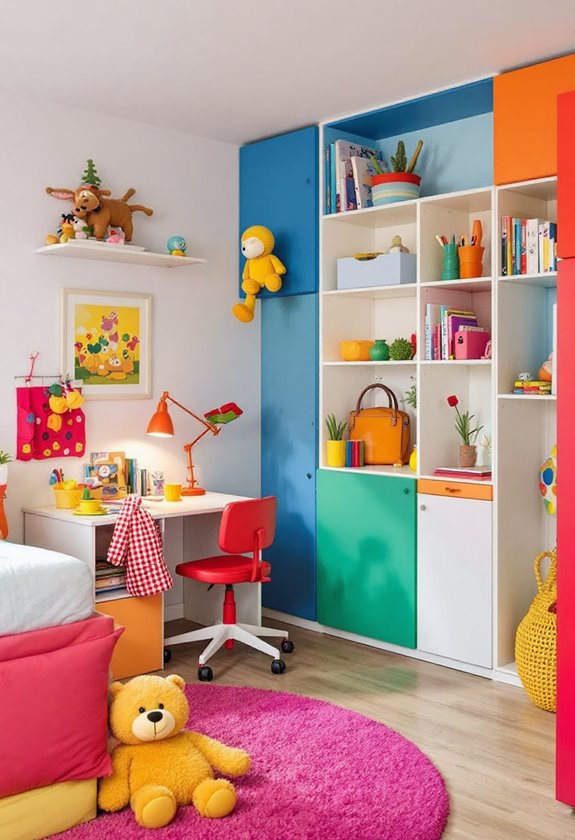
Selecting multi-functional furniture is essential for maximizing space in a children's room while accommodating their evolving needs. Envision a loft bed that transforms a mundane sleeping area into a lively haven for study and play. This clever space-saving solution not only creates a cozy nook for dreams but also frees up precious floor space for all those spontaneous dance parties.
Consider a bunk bed; it's not merely a sleeping arrangement, but a launching pad for creative adventures. With a desk or play area tucked underneath, your child can seamlessly shift from dreaming to doing. Incorporating furniture versatility is key—opt for stylish collapsible dollhouse chairs that double as toy storage; now that's multitasking at its finest! Additionally, these chairs promote organization of toys and accessories, ensuring a tidy play area.
Don't forget about wall-mounted foldable desks, which can vanish from sight when not in use, leaving room for a wild game of tag.
And if you're really feeling adventurous, look into modular activity tables; as your child grows, so too can their furniture.
In a world where space is limited and creativity knows no bounds, multi-functional furniture becomes not just a necessity but a delightful part of your child's playful journey!
Organizing With Themed Storage
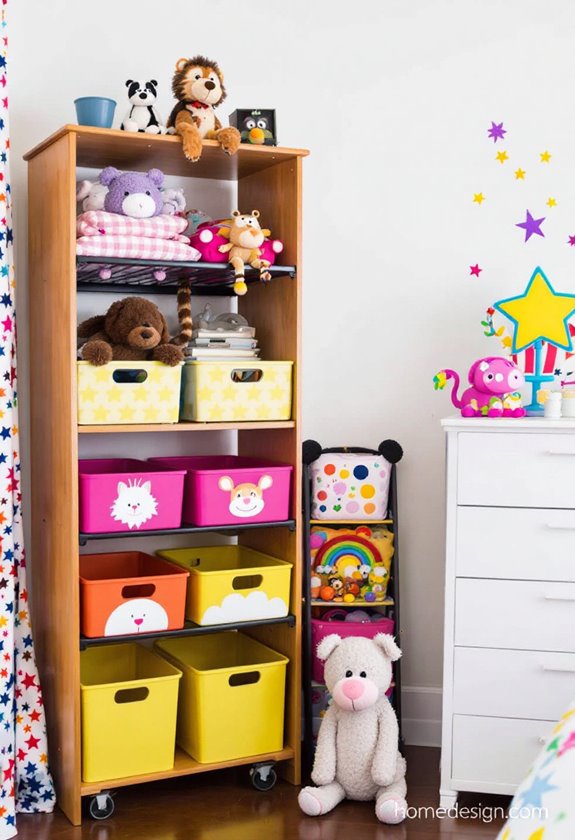
Creating an organized and playful environment in a children's room can be achieved through the use of themed storage solutions. Think of vintage suitcases and trunks, tucked away, holding board games and toys, whispering tales of adventures past. They not only serve a purpose but also add a charming, nostalgic touch to the room.
Pairing these with bright open shelving—like a sunshiny yellow bookcase—brings a sense of playful aesthetics, inviting kids to explore. Wall-mounted shelves can also be incorporated to keep toys off the floor, displaying them as decor and further enhancing the playful theme.
Utilizing themed storage bins, such as whimsical pineapple motifs, injects fun into organization, while labels in playful fonts empower children to take responsibility for their treasures.
Envision a dress-up rack adorned with hats and costumes, turning the mundane act of tidying up into a whimsical game.
People are Asking
How Can I Involve My Child in Theme Selection?
Involve your child in theme selection by initiating theme brainstorming sessions that highlight their preferences. Encourage open discussions about interests, incorporating their favorite characters or colors, thereby fostering a collaborative and engaging decision-making process.
What Budget-Friendly Options Exist for Themed Decor?
Budget-friendly options for themed decor include DIY decor ideas like wall decals and framed illustrations, as well as thrift store finds such as colorful textiles and unique furnishings, creating an engaging atmosphere without excessive expenditure.
How Often Should I Update the Room's Theme?
Updating a child's room theme should ideally occur every one to two years, allowing for seasonal updates and growth adjustments. This frequency accommodates changing interests while minimizing the financial and logistical burdens of extensive redecorations.
What Are Some Safety Considerations for Children's Rooms?
Consider a scenario where a toddler pulls a dresser onto themselves, highlighting the importance of childproof furniture. Additionally, ensuring window safety with secure locks prevents accidental falls, safeguarding children in their environment.
Can I Mix Different Themes in One Room?
Yes, you can mix different themes in one room. However, it is essential to guarantee cohesive design through careful selection of theme combinations, maintaining a balance that avoids chaos while promoting visual harmony and unity.
Wrapping up
In summary, the creation of a playful theme for a children's room serves not merely as a design choice but as a canvas for imagination and growth. Just as Peter Pan invites children to never grow up, a thoughtfully designed space can foster creativity, exploration, and learning. By integrating interactive elements, lively colors, and personalized touches, the room transforms into a sanctuary where dreams take flight and adventures await at every turn.






